What tactics do the Netherlands use? What is Senegal’s weakness? Which quirk should we look out for from Ecuador?
The 2022 World Cup is nearly upon us and The Athletic will be running in-depth tactical group guides so you will know what to expect from every nation competing in Qatar.
Liam Tharme will look at each team’s playing style, strengths, weaknesses, key players and highlight things to keep an eye on during the tournament.
Advertisement
Expect to see screengrabs analysing tactical moments in games, embedded videos of key clips to watch, the occasional podcast clip and data visualisation to highlight patterns and trends — think of yourself as a national team head coach and this is a mini opposition dossier for you to read pre-match.
We start, unsurprisingly, with Group A, which pits the hosts Qatar against Senegal, Netherlands and Ecuador.
You can find Group B here and the rest of the groups (C to H) will be published throughout the week…
Senegal
- Manager: Aliou Cisse (since 2015)
- Captain: Kalidou Koulibaly
- Qualifying record: P8, W6, D1, L1, GF16, GA5
- World Cup debut: 2002 (Quarter-finals)
- 2018 World Cup: Group stage (3rd)
- Average age of squad in qualifying: 28 years 6 months
- Most caps in squad: Idrissa Gana Gueye (94)
- Top scorer in squad: Sadio Mane (33)
How do they play?
Aliou Cisse’s side enter the tournament with deservedly high expectations as champions of Africa. They won their first-ever Africa Cup of Nations (AFCON) in February, beating Mohamed Salah’s Egypt on penalties. They then sealed their place at the World Cup by beating Egypt in a play-off.
Cisse’s team line up in a 4-3-3. The midfield three is narrow but fluid to allow the full-backs to push on and create a front five. Their strengths are out wide, namely Bayern Munich’s Sadio Mane and Watford’s Ismaila Sarr, who regularly combine with the full-backs and drop deeper to receive possession from Senegal’s central defenders.
Senegal’s pass map from the AFCON final illustrates their shape, with left winger Mane (No 10) and right winger Sarr (No 18) rolled inside. A national team with plenty of Premier League experience, their fluid central midfielders were Idrissa Gueye (No 5), Nampalys Mendy (No 6) and Cheikhou Kouyate (No 8).

In build-up, the central midfielders would regularly drop between or beside either central defender and act in a quarterback-style role, while the full-backs pushed on. In the fifth minute of the AFCON final, Gueye dropped deeper and found Saliou Ciss with a through ball over the Egypt defence which led to a penalty for Senegal, though Mane’s spot-kick was saved. They won the game 4-2 on penalties, with Mane making amends for his earlier miss by scoring in the shootout.
Often, this pattern is worked on the left to push the left-back Ciss on and allow Mane to roam. Forty-four per cent of Senegal’s AFCON attacks were down the left-hand side, with 34 per cent down the right.
With quality ball carriers in Mane and Sarr, Senegal can exploit teams on the break in Qatar — only Burkina Faso (18) had more direct attacks than Cisse’s side (13) at the latest AFCON.
Advertisement
But it is defensively where the Lions of Teranga really shine. Under Cisse, they have conceded only 51 goals in 77 games, in that time posting the best defence at the last two AFCONs. The Chelsea goalkeeper Edouard Mendy has kept 14 clean sheets in 24 caps and, as per FBref, ranked fourth in the Premier League last season for save percentage (73.7%). Despite some struggles at club level this season, during his time at Chelsea he has won the Champions League, FIFA Club World Cup and UEFA Super Cup.
As shown in the graphic below, at AFCON 2021, Senegal shipped only two goals and conceded tournament-low per-game totals for xGA (expected goals against) and shots on target conceded en route to lifting the trophy.
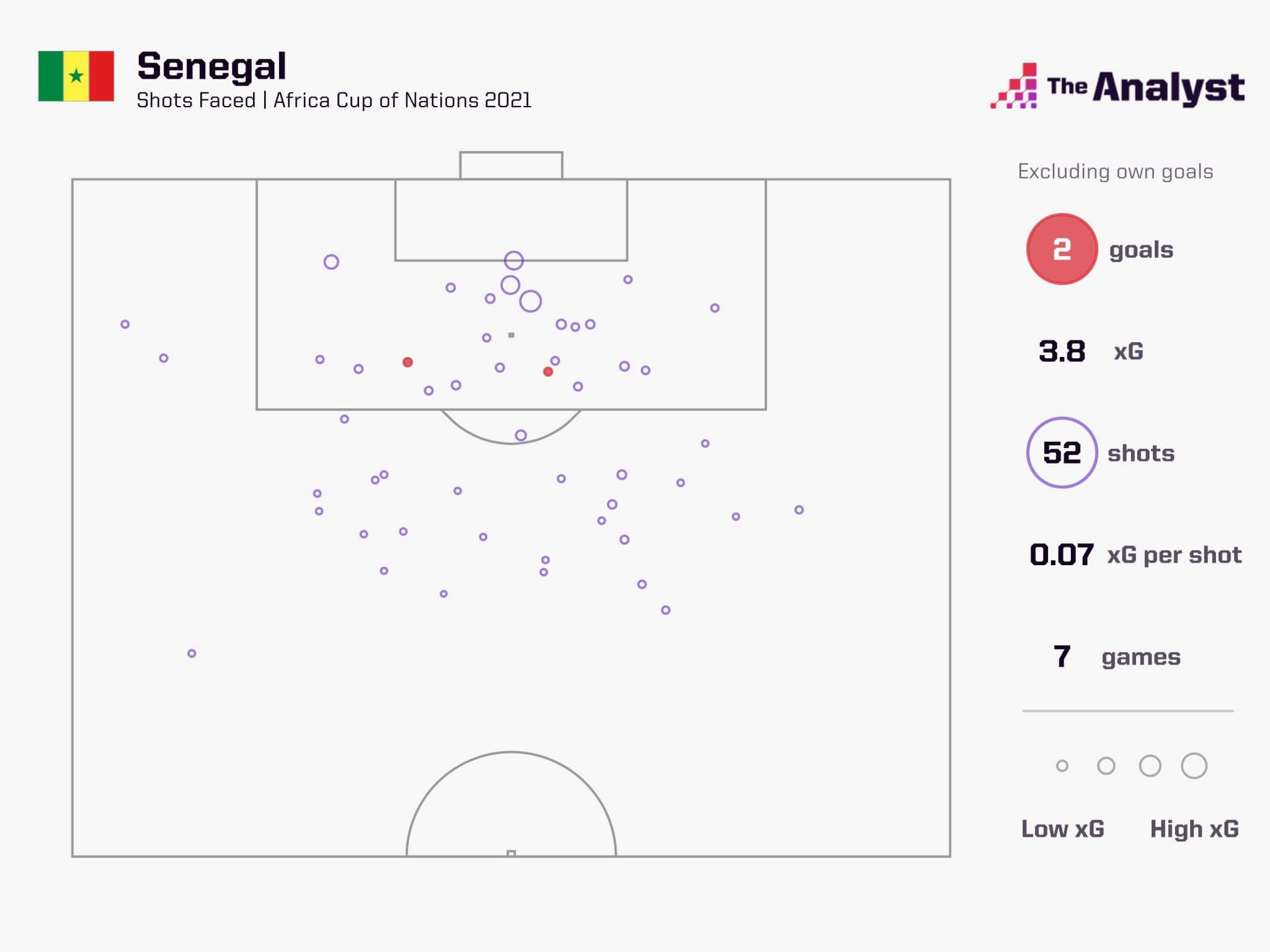
Senegal often press — and press well — in their 4-3-3 shape but revert to a 4-4-2 when mid-block defending — defending with all their players in the middle third of the pitch and allowing opposition defenders to have the ball. Their horizontal and vertical compactness tends to prevent teams from making much headway in central areas. They hold a high line well and the back four have the pace to defend balls played in behind.
Throw in Mendy’s sweeper-keeper and cross-claiming abilities and Senegal are often hard to create and score against.
Their key player(s)
Sarr and Mane, summed up by them providing the most goal involvements (goals + assists) for Senegal in World Cup qualifying (four and seven respectively).
Watford’s Sarr is a natural-sided winger (a right-footer on the right) and has 10 goals in 47 caps, often scoring from cutbacks.
When playing for Senegal, Mane operates inverted on the left and causes havoc in a similar fashion to how he did in the Premier League — coming inside onto his dominant right foot to shoot or create.
They rely on his creativity as much as finishing, with Mane having the same amount of shots as chances created (13) at AFCON, Senegal’s top player in both stats. He has scored once at a World Cup (vs Japan in 2018).
What is their weakness?
Starting slowly.
Senegal scored just once in their three AFCON 2021 group games and only beat Zimbabwe in the opening round thanks to Mane’s injury-time penalty.
They outperformed, outpassed and outshot Egypt in the first half of the final — notably missing an early penalty — but were a significantly better second-half side, which rang true across the tournament.
| Metric | First Half | Second Half |
|---|---|---|
33 | 57 | |
11 | 18 | |
3.99 | 7.75 | |
1 | 8 | |
3 | 14 |
One thing to watch out for…
Koulibaly’s passing range. He repeatedly hit big diagonals for Napoli and the Senegal captain does it for his country, too. Koulibaly completed the most long passes of any outfield player at AFCON 2021 (46).
Teams will likely defend in a mid-block with their players in the middle third of the pitch rather than press in Qatar, given the climate and match significance. This would give Koulibaly the opportunity to unlock defences with his long-range passing. He regularly finds the No 9, full-backs or Mane or Sarr, which helps carve out one-v-one opportunities for Senegal.

Netherlands
- Manager: Louis van Gaal (since August 2021)
- Captain: Virgil van Dijk
- Qualifying record: P10, W7, D2, L1, GF33, GA8
- 2018 World Cup: Failed to qualify
- Average age of squad in qualifying: 27 years 6 months
- Most caps in squad: Daley Blind (94)
- Top scorer in squad: Memphis Depay (42)
How do they play?
Principally, like a Dutch national side — high pressing, expansive style, fluid football with positional rotations. But shape-wise, less so. Louis van Gaal adopted a 4-3-3 in qualifying, but in recent Nations League fixtures he has switched to a 3-4-1-2.
While this shape change is not the Liverpool centre-back Virgil van Dijk’s favourite, it crucially fits Van Dijk, Frenkie de Jong and Memphis Depay. They are the core of this Dutch side.
“I think we have a marvellous group. This is not the first time. It shall not be the last time,” said Van Gaal after they beat Wales in June.
Their pass network from their 4-2 win against Denmark in March illustrates this 3-4-2-1 shape — wing-backs that push on and a No 10 operating close to the front two.

Often, either De Jong or his central midfield partner Teun Koopmeiners will drop deep to link play from front to back.
To break the Germany high press in a 1-1 draw in March, the midfield pair made coordinated movements to the right…

… so that De Jong could receive beyond the first line of pressure…

… and break the midfield line with a pass out to the advanced right wing-back Denzel Dumfries. But for an offside flag, Netherlands would have been through.

While the Dutch are very capable of elaborate passing sequences, they are most threatening when attacking vertically — typically this means passes into Depay, and the Netherlands keep their front two high when defending.
Exhibit A: the second goal away at Belgium in the Nations League.
Steven Berghuis finds Depay with a quick through ball after making an interception in midfield.


Out of possession, they press particularly intensely in wide areas, often going wing-back to opposition full-back in duels — a prime example of this can be found in the build-up to their opening goal against Wales.
They repeatedly played a ridiculously high line against Germany and are more than capable at baiting opponents into overplaying and stretching their horizontal shape, leaving holes.
Netherlands dominated the ball and opponents in their June Nations League fixtures. They averaged over 58% possession and outshot opponents 62-35.
Opponent | Possession (%) | Shots (on target) | Goals (xG) | Shots conceded (on target) | Goals conceded (xGA) |
|---|---|---|---|---|---|
50 | 15 (7) | 4 (2.5) | 13 (6) | 1 (1.3) | |
56 | 8 (2) | 2 (0.5) | 8 (3) | 1 (0.3) | |
68 | 17 (6) | 2 (2.7) | 5 (3) | 2 (0.8) | |
60 | 22 (7) | 3 (1.5) | 9 (4) | 2 (1.3) |
Their key player(s)
De Jong and Depay.
Van Gaal describes the Barcelona midfielder De Jong as a player who can “gift the pass”. Against Germany earlier this year, he unlocked the defence with a wedge pass into wing-back Dumfries, who assisted Steven Bergwijn.
And at home to Denmark, De Jong, in trademark fashion, received on the half-turn from the goalkeeper, drove through the midfield and then passed into Bergwijn to score. He moved the Netherlands from box to box in 10 seconds.
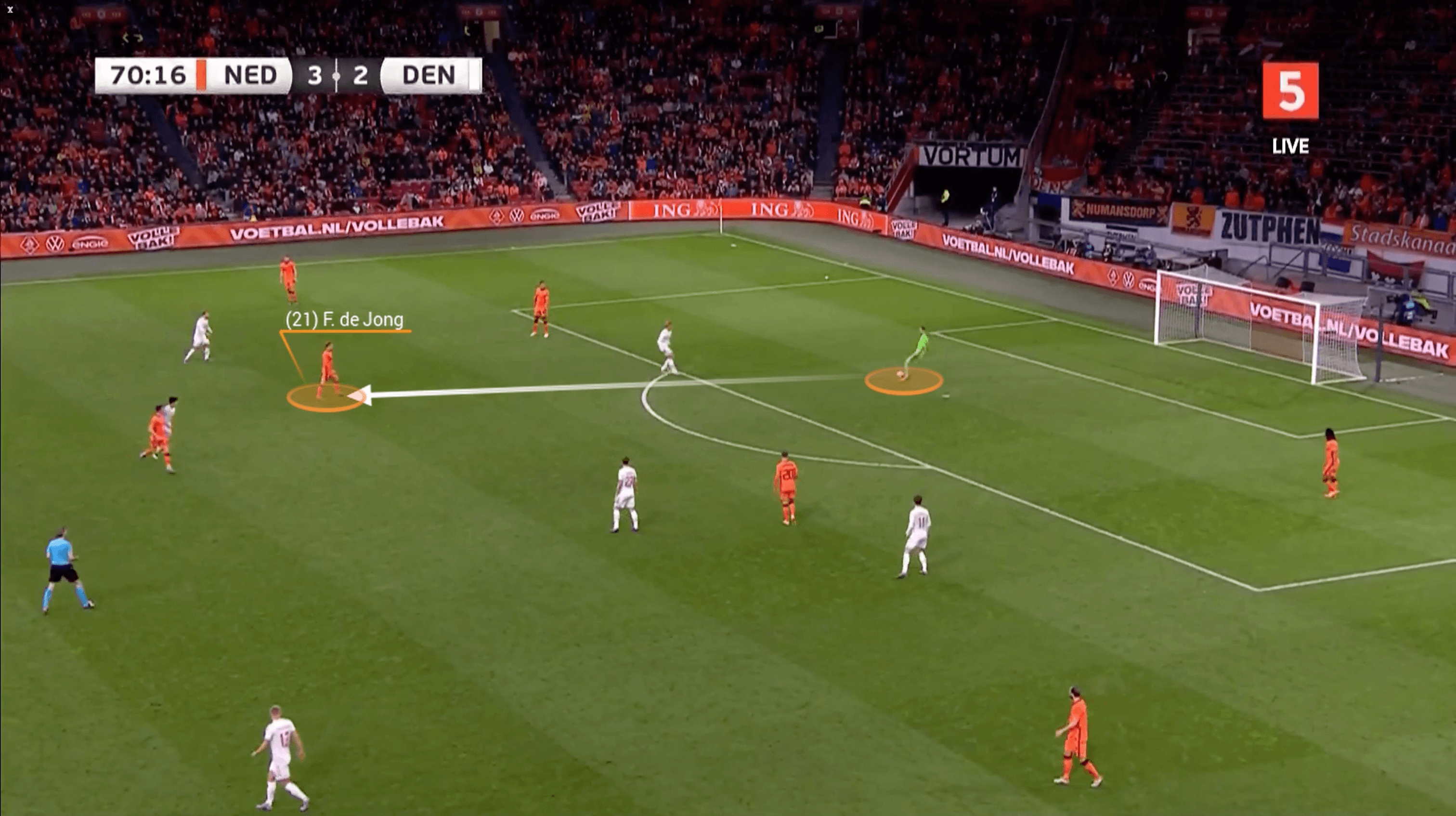


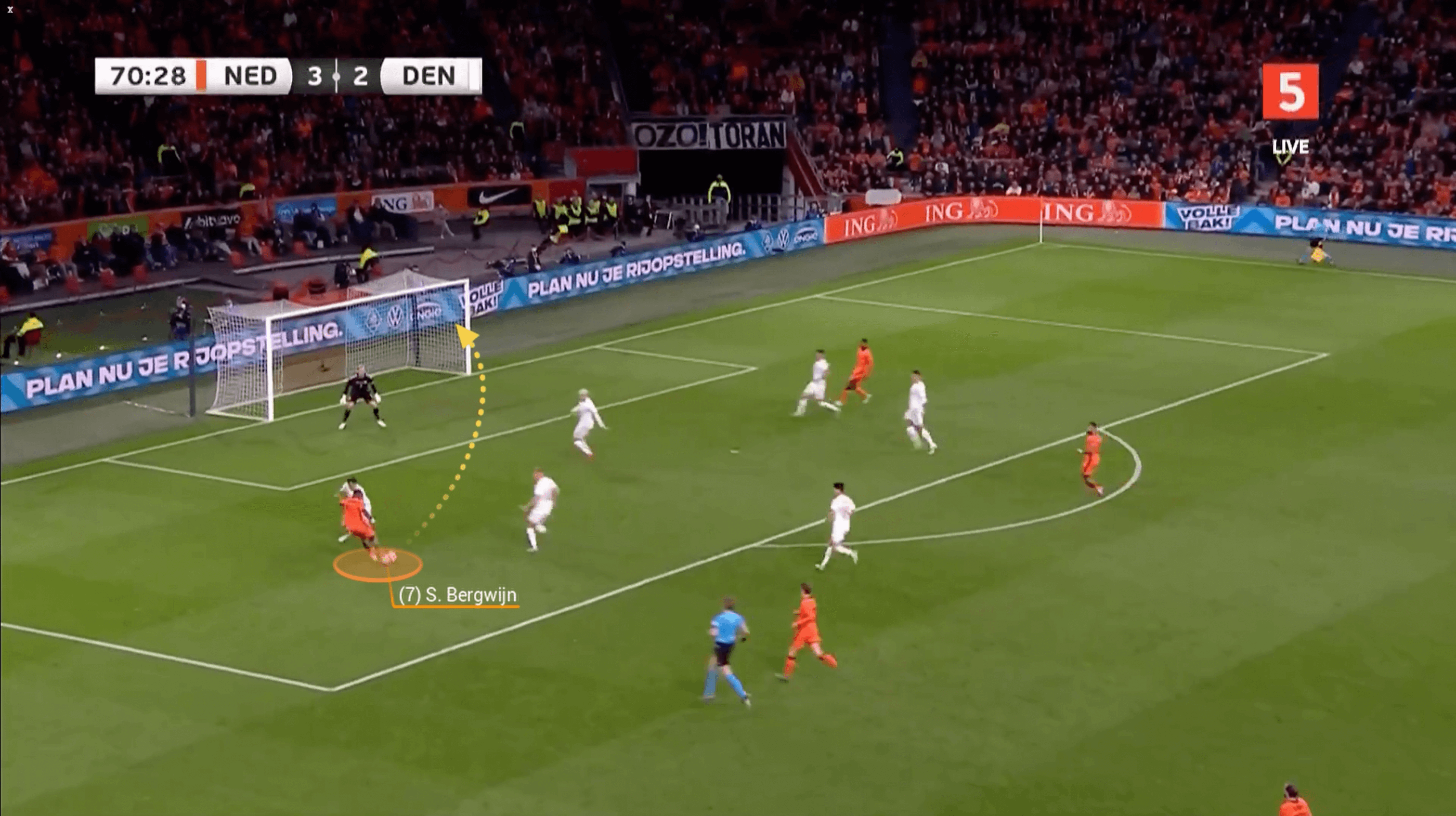
As per FBref, Depay had the most shots (58) in UEFA’s World Cup qualifying and finished as joint top scorer alongside Harry Kane (12). Here’s his shot map for that qualification campaign, showing lots of high-quality chances inside the six-yard box.
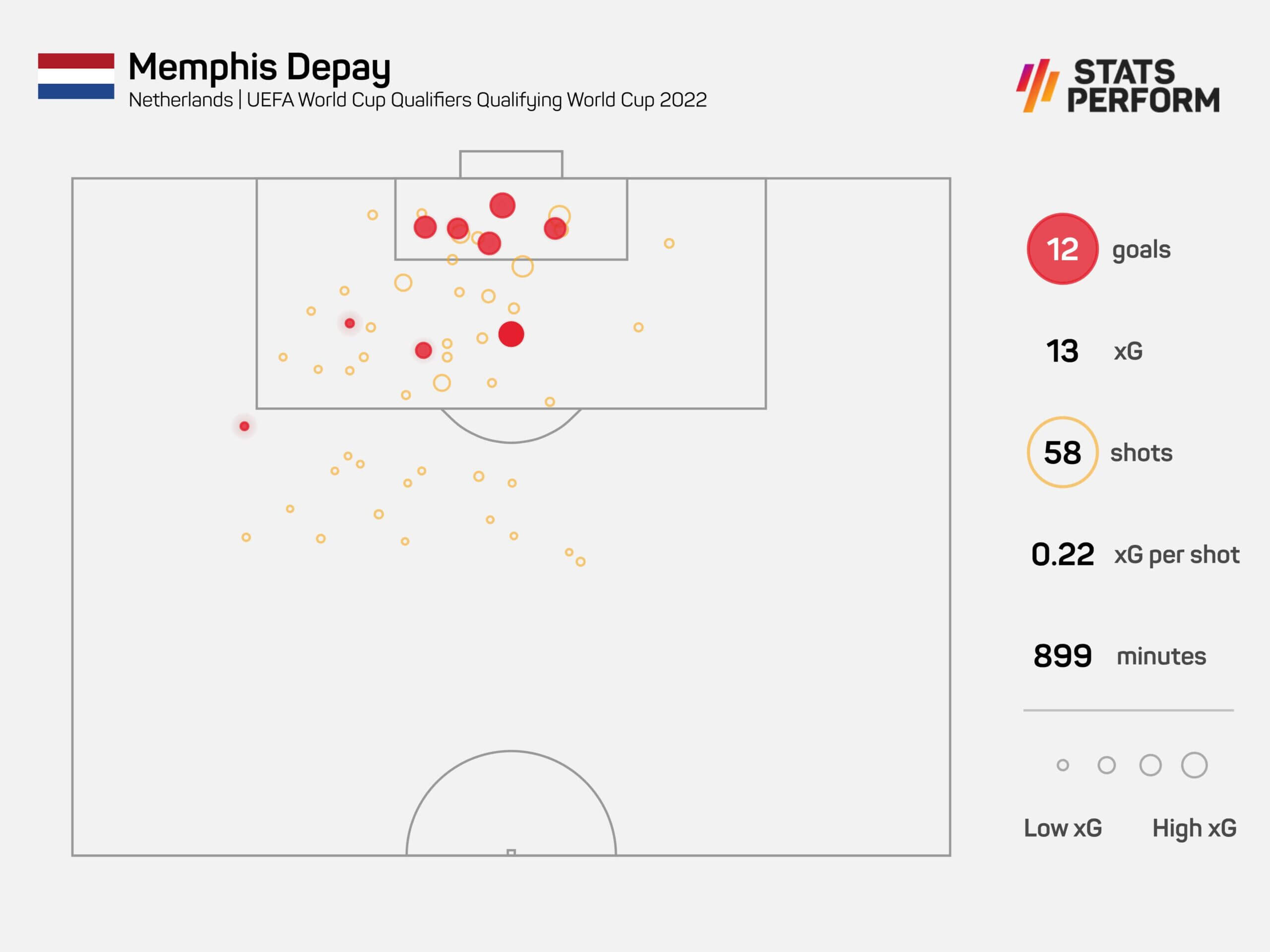
He scored regularly on counter-attacks but showed important versatility and quality in attacking positioning to finish from crosses, cutbacks and combination play.
Some may remember him as a winger, but he has a fluid attacking role in Van Gaal’s system — at times he drifts wide and looks to dribble, but he often positions himself on the last line of defence and looks for one-touch opportunities to finish and chances to run in-behind.
Depay is also the Dutch penalty taker and has scored 10 of 13 attempts from the spot.
The former Manchester United forward has been out for Barcelona with a thigh problem since September but is expected to be named in Van Gaal’s squad.
What is their weakness?
Clean sheets. Well, a lack of them.
They have conceded at least once in nine of 15 games under Van Gaal and their expansiveness in possession and positional rotations does make them porous — see Brennan Johnson’s goal for Wales as evidence of this.
Only two sides (England — 39, Germany — 36) scored more goals than the Netherlands in European qualifying for the World Cup, but 14 teams conceded fewer.
Read more: How to win the World Cup: The lessons teams can learn from previous winners
One thing to watch out for…
Wout Weghorst.
His physical and style profile is more akin to that of a target man, particularly when compared to the hybrid winger-forwards; Depay, Bergwijn and Cody Gakpo.
Weghorst only has 14 caps in four years but featured in all their games at Euro 2020. He facilitates more direct play and often occupies central defenders to pin the defensive line and create space for advanced midfielders and wing-backs.
Weghorst got the winner against Wales with a headed finish to cap a flowing attacking move, spearheaded by De Jong’s combination play and ball carrying.
Ecuador
- Manager: Gustavo Alfaro
- Captain: Enner Valencia
- Qualifying record: P18 W7 D5 L6, GF27, GA19
- 2018 World Cup: Failed to qualify
- Average age of squad in qualifying: 26 years 4 months
- Most caps in squad: Enner Valencia (74)
- Top scorer in squad: Enner Valencia (35)
How do they play?
The youngest side in South American World Cup qualifying, Gustavo Alfaro has shaped Ecuador into an exciting, attacking and defensively resilient side. Primarily they adopt a 4-3-3 shape and are built around a dynamic and balanced midfield three, coupled with fast, technical wingers, particularly the 22-year-old Gonzalo Plata, who plays his football in Spain for Valladolid.
Advertisement
The graphic below demonstrates the attacking style of a team in their possession approach: passes per sequence — the X axis — is the average number of passes a team makes per one whole possession, with more expansive teams (see Brazil and Argentina) recording higher rates. Direct speed upfield — the Y axis — records how quickly a team moves the ball forward, with more direct teams (see Bolivia) returning higher rates.
Ecuador sit close to the median in both metrics, the closest team to both median in fact, which indicates a level of balance to their play style. They can and do play fast and direct but are also capable of being slow and intricate, which balances them out.

Ecuador regularly build from the goalkeeper and Bayer Leverkusen’s 20-year-old left-footed centre-back Piero Hincapie, who offers quality ball progression. They push their full-backs on and central midfielders are always moving.


Ecuador are good, not great, in open play but did out-shoot and outscore opponents in qualifying for the World Cup.
| Metric | Ecuador | Opponents |
|---|---|---|
Shots | 203 | 183 |
xG | 24.32 | 20.77 |
Goals | 27 | 19 |
Big chances | 37 | 21 |
Possession | 51.1 | 48.9 |
PPDA | 10.5 | 11.2 |
Notably, when defending in a low block, Ecuador always kept at least one player up and regularly launched counter-attacks through ball carries and forward passes into the advanced player(s).
Out of possession, while they would press in a 4-3-3, they dropped into a 4-4-2 when mid-block defending.


Like Senegal, this vertical and horizontal compactness often prevented teams playing through them, but the midfield partnership operated zonally. They did not track runs from opposition midfielders and were susceptible to line-breaking passes into roaming players.
Consequently, their central midfielders ended up committing fouls quite often — Brighton’s rising star Moises Caicedo made the second-most fouls (32) of any South American in World Cup qualifying.
Their key player(s)
Their record appearance holder and goalscorer Enner Valencia will be part of the squad but played only 47 per cent of possible minutes in qualifying.
In addition to Hincapie (20 years old) and Plata (22), Brighton’s Caicedo (21) and Pervis Estupinan (24) are central to this emerging generation of Ecuadorian talent.
Advertisement
Caicedo’s ability to blend a combative style with slick passing has caught the eye at Brighton. He was directly involved in six goals (two goals, four assists) in qualifying — the second-most for Ecuador — and the presence of a deep-lying midfielder (often Carlos Gruezo) facilitates the 21-year-old to push forward.
Estupinan provided a regular creative threat through crosses in both open play and from set-piece situations, as shown below.
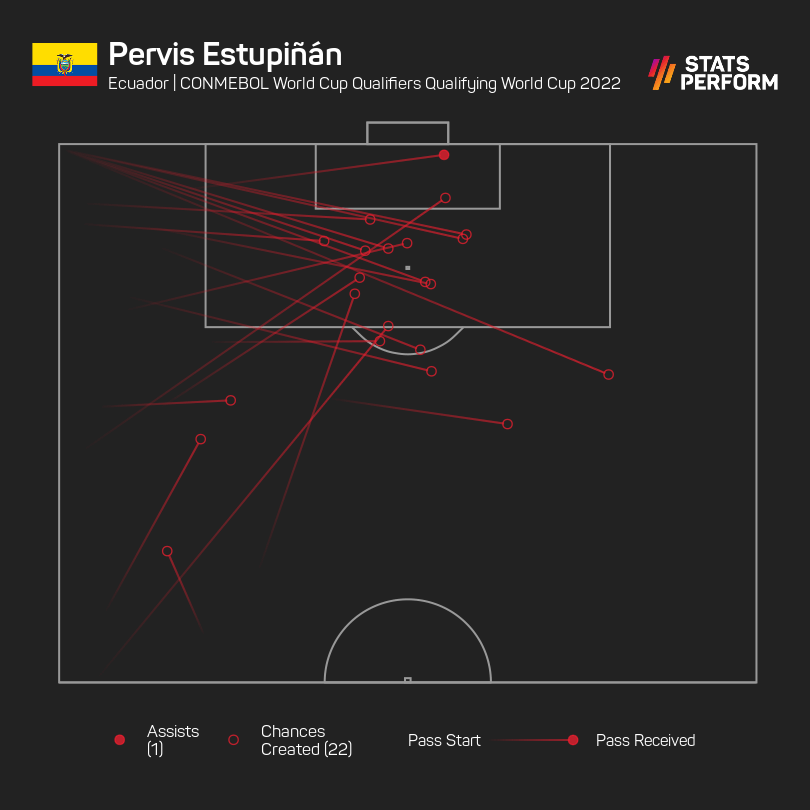
As per FBref, his 107 crosses were the most of any South American in qualifying.
What is their weakness?
Winning games. They drew all three group games at Copa America 2021 and have drawn 10 of their 29 games under Alfaro (11 wins and 8 losses).
Ecuador are a side that succeed thanks to a pretty strong defence. They conceded more than once in only one of seven games in 2022 but never scored more than one goal themselves in those fixtures.
Against higher-quality sides they more than hold their own and are incredibly competitive, but they often struggle to break down sides of similar quality.
One thing to watch out for
Attacking set pieces. Ecuador were the best South American team in qualifying when it came to set pieces (excluding penalties).
| Metric | Ecuador WCQ Total | CONMEBOL Rank |
|---|---|---|
70 | 1st | |
7.57 | 1st | |
35% | 1st | |
8 | 1st |
Their clustering of players around the penalty spot often caused chaos against blockers and player-marking schemes — they would split and run in different directions. Often the player at the back of the pack was the target for this.

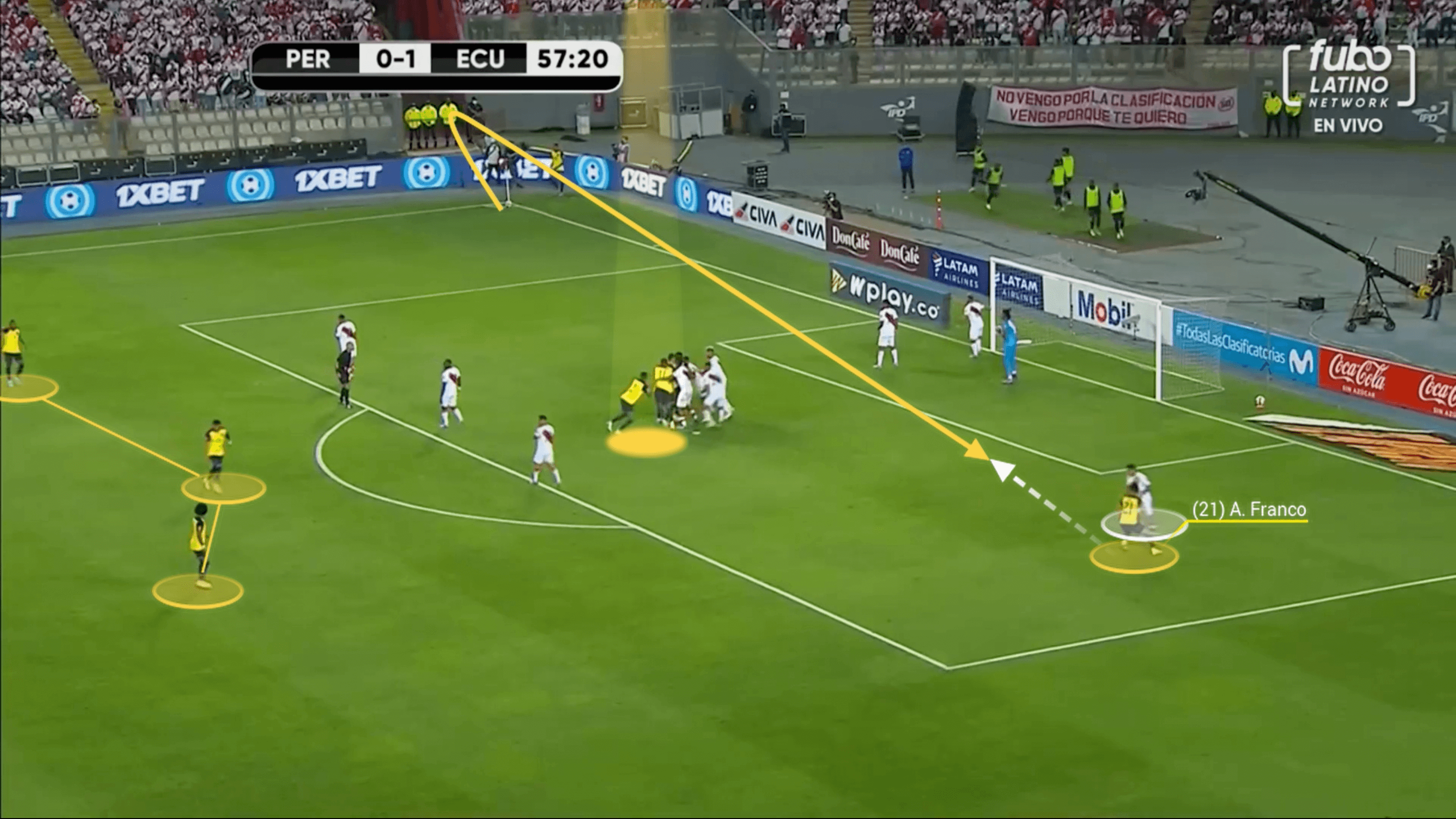
Qatar
- Manager: Felix Sanchez Bas
- Captain: Hassan Al-Haydos
- Qualifying record: W2, D3, L5 GF8 GA23*
- 2018 World Cup: Failed to qualify
- Average age of squad: 26 years 7 months
- Most caps in squad: Hassan Al-Haydos (160)
- Top scorer in squad: Almoez Ali (39)
*participated in qualification games as friendlies, automatically qualified as hosts.
How do they play?
Qatar are an aesthetically pleasing side to watch. Under Spanish head coach Felix Sanchez Bas, they have alternated between a 4-3-3 and 3-5-2, though settled on the latter in recent fixtures and against higher-quality sides.
Without the ball, the wing-backs drop down and often get pinned deep in a 5-3-2.
While Qatar are relatively solid when defending in a mid-block, they were porous as a pressing outfit — deep wing-backs required the outside central midfielders to press opposition wide players and cover unrealistically large distances.
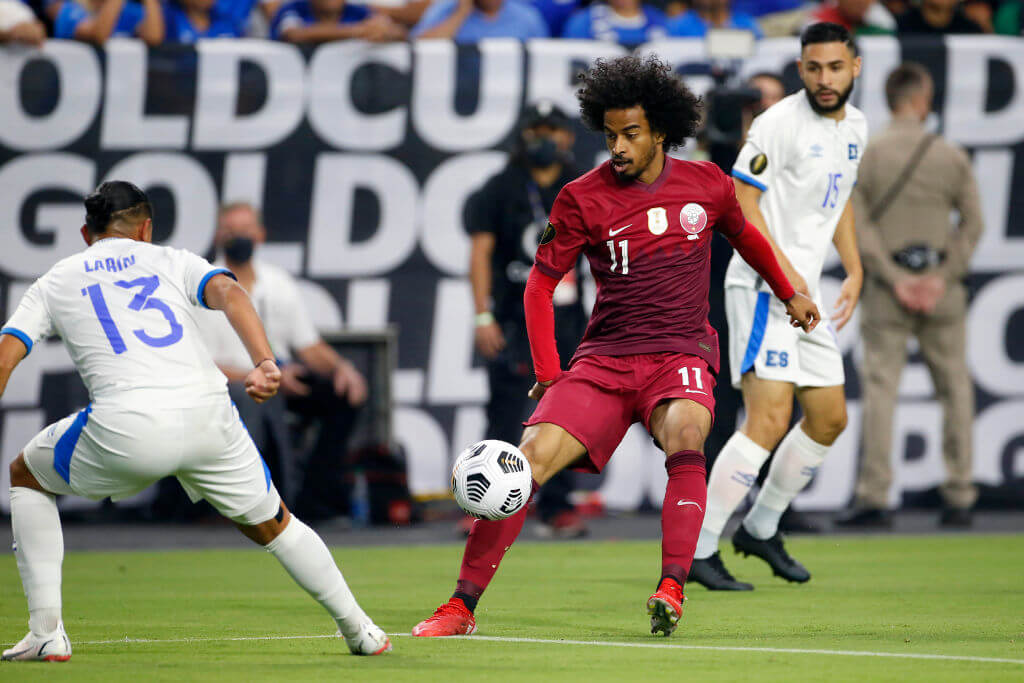
GO DEEPER
The tactics behind Qatar's run to the Gold Cup semifinal
In the 2019 Asia Cup final against Japan and 2021 Gold Cup semi-final against the United States, Sanchez Bas’ side only pressed high from opposition goal-kicks and blocked the middle third effectively.
The examples below show that clear 5-3-2 defensive shape.

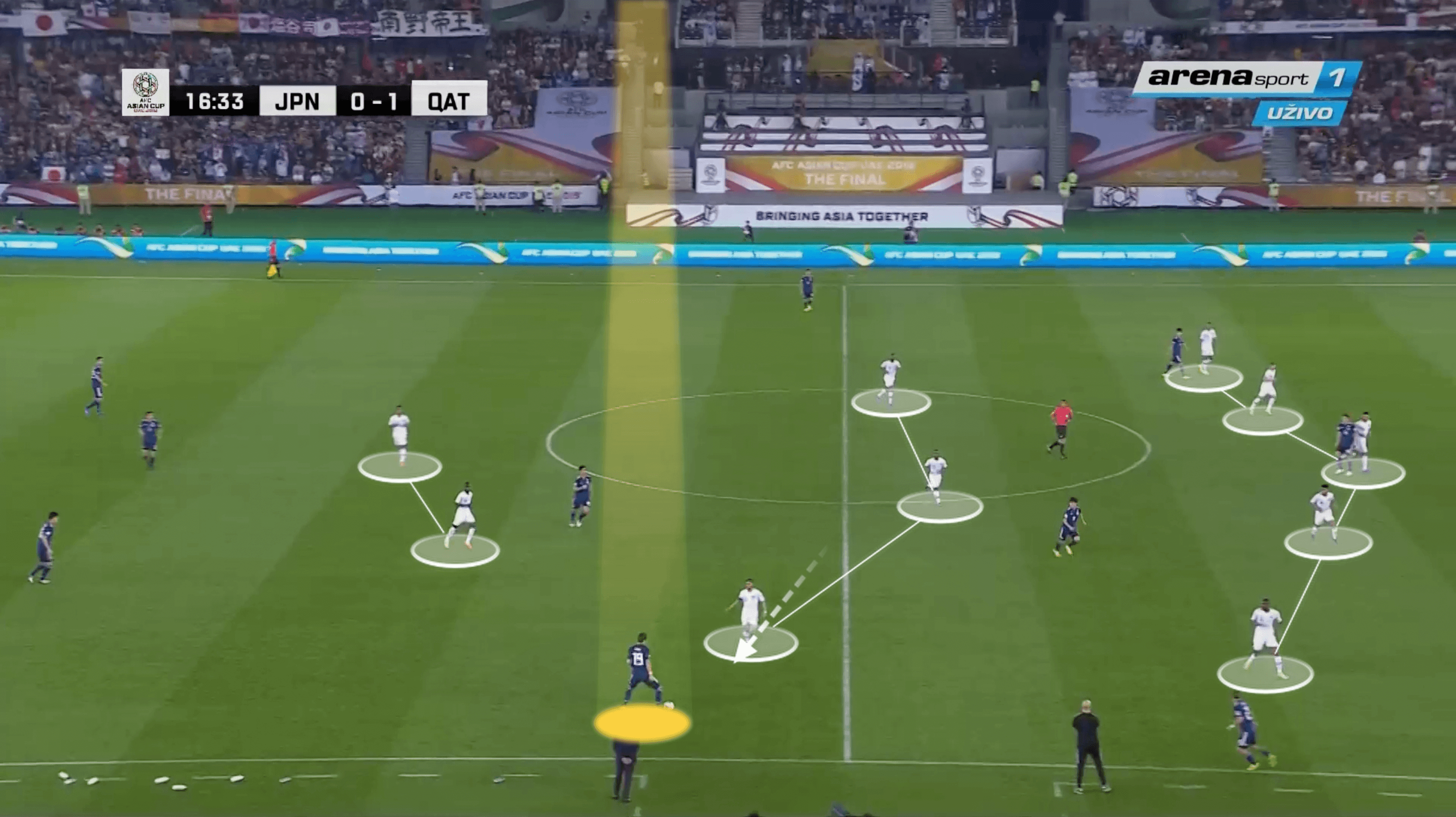

As part of their World Cup preparations, Qatar were invited to participate in numerous international tournaments. And just like South Korea, who reached the semi-finals at their home World Cup in 2002, Qatar are conducting a six-month-long training camp involving friendlies against various nations and domestic clubs.
| Year | Tournament (Confederation) | Eliminated at |
|---|---|---|
2021 | Arab Cup (AFC) | Semi-final (third-place play-off winners) |
2021 | Gold Cup (CONCACAF) | Semi-final |
2019 | Copa America (CONMBEOL) | Group stage |
2019 | Asian Cup (AFC) | Winners |
In possession, they look like a team coached by a Spaniard. Qatar frequently look to build expansively through the thirds and attack with slick passing combinations. At the 2021 Arab Cup, where Qatar finished third, they ranked second for successful line breaks per game and had the most switches of play.
Advertisement
The team style graphic below is the same as what we looked at for Ecuador, showing passes per sequence, how elaborate the average possession is for a team, and direct speed, how quickly they move the ball upfield.
Qatar rank on the peripheries of the slow and intricate corner of the scatter plot, which points to a tendency to attack with higher passing sequences than the average 2021 Gold Cup side. Lying on the median line for direct speed, there is plenty of forward movement to their play and they will at times play directly.

Their first goal in the 2019 Asia Cup final — a bicycle kick — came from a sequence of eight consecutive passes, and their second goal from a sequence of 22.
That control, that bicycle kick 😱
Was this acrobatic attempt by #AsianCup2019 top-scorer, Almoez Ali your best goal of the tournament?
Vote here 👉 https://t.co/NdWlM1mwcO pic.twitter.com/rmU78HzOMK
— #AsianCup2023 (@afcasiancup) February 4, 2019
Qatar regularly threatened teams with vertical, direct attacks in attacking transition and regularly looked to exploit teams on the counter-attack. This is why they leave Almoez Ali and Akram Afif high out of possession, ready to spring when the opportunity arises.
Their key player(s)
Afif and Ali, individually and collectively.
Akram, his first name, is derived from the Arabic word for generosity, which is particularly apt for Afif. He set a tournament record with 10 assists and 26 chances created at the 2019 Arab Cup, and was involved in all three goals in the final.
He has continued to perform for Qatar at major tournaments and took home the bronze ball at the 2021 Arab Cup. His former club manager Xavi has claimed “there are no limits for him”.
The graphic below is from the FIFA Training Centre analysts and offers a granular insight into his technical performance at the tournament. Once more he had the most assists (four), regularly looking to receive passes in behind the opposition and one-third of his passes broke opposition lines.

Ali is third in the all-time Qatar goalscorer list and took the Golden Boot at both the Asia Cup (nine goals in seven games) and the Gold Cup (four goals in five games).
Notably, Ali has scored all 13 of his senior penalties for club and country. In open play, he frequently scores from a mix of counter-attacks, through balls and crosses, by positioning and repositioning himself to find space, and he is comfortable in shooting with both feet.
Afif is regularly the provider of the assist for Ali.

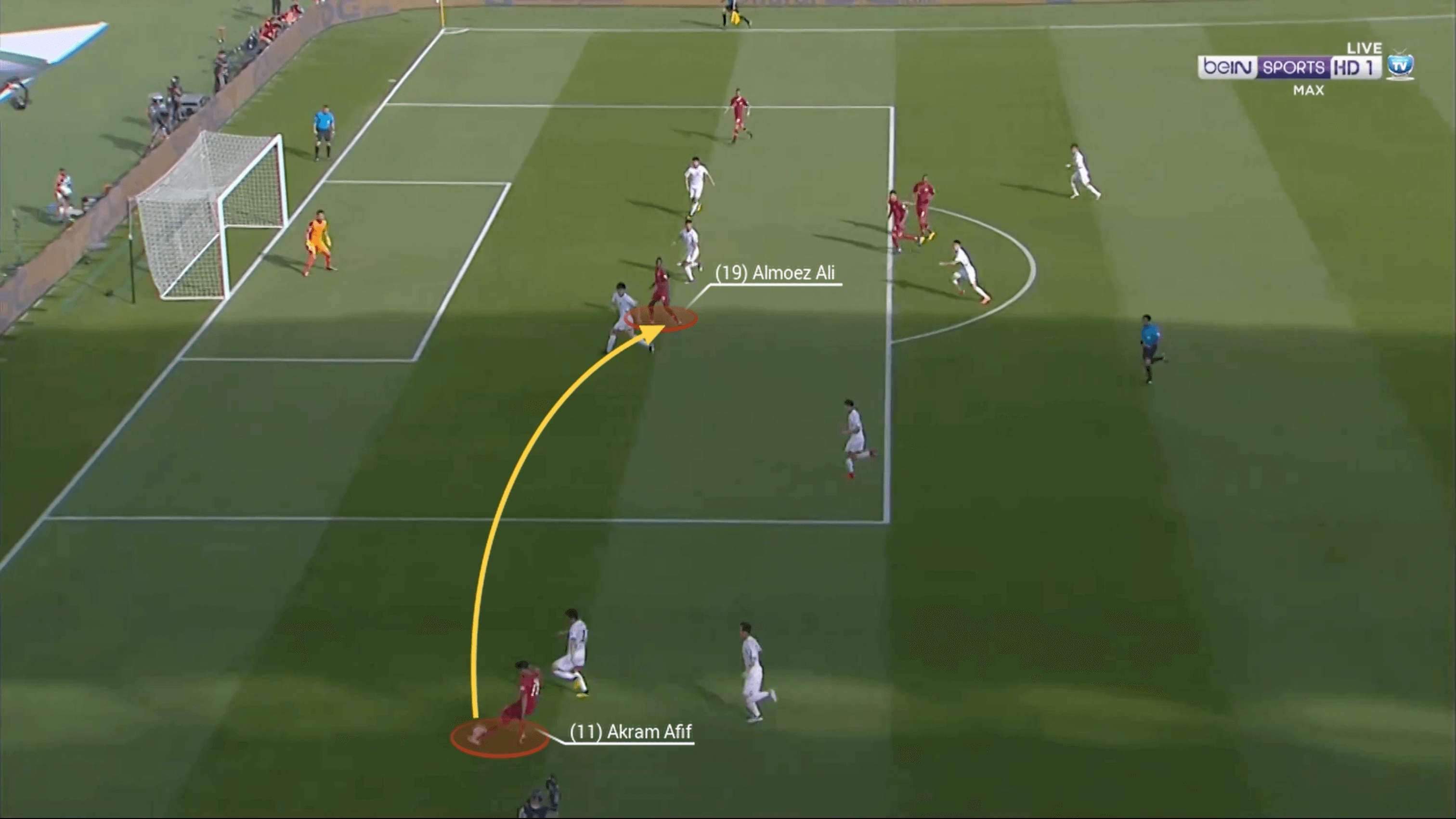

What is their weakness?
Playing against quality opposition. Since the 2018 World Cup, 38 of Qatar’s 56 fixtures have been against sides ranked outside the top 50 in the world rankings.
Qatar have three wins, three draws and 12 losses against top 50-ranked sides over the last four years, and were outscored 33-12 in those fixtures.
Advertisement
Their comparative record to World Cup-level teams is best illustrated through ‘qualifying’. UEFA integrated Qatar with Group A qualification and they played friendlies home and away.
If you include those friendly fixtures and Qatar to the qualification table — taking it from eight games to 10 for all teams — then they finished below Luxembourg with the worst defence and joint-worst attack.
Team | Games | W | D | L | GF | GA | PTS |
|---|---|---|---|---|---|---|---|
10 | 8 | 2 | 0 | 26 | 0 | 26 | |
10 | 7 | 2 | 1 | 23 | 7 | 23 | |
10 | 3 | 4 | 3 | 16 | 9 | 13 | |
10 | 3 | 1 | 6 | 9 | 20 | 10 | |
10 | 2 | 3 | 5 | 8 | 23 | 9 | |
10 | 0 | 2 | 8 | 8 | 22 | 2 |
One thing to watch out for
Throw-ins.
Qatar have a basketball-style crossover that they use at throw-ins typically within their own half.
The more advanced player (Afif) is the target and drops deep, with the space created for them by a forward runner…

… and by throwing the ball across the body of the player they can play an early big switch to the far-side wing-back.
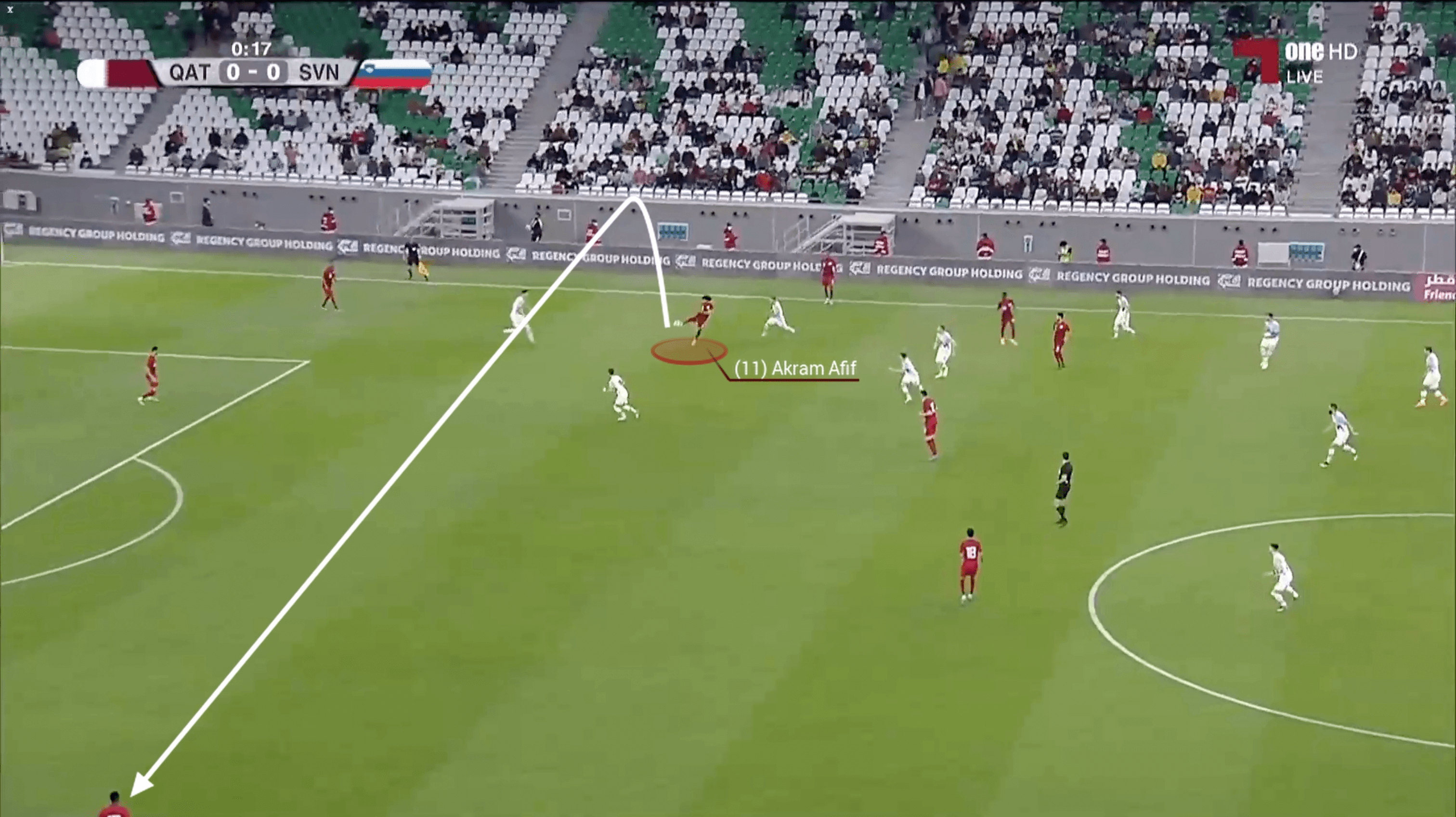
Here is a second example, with Ali.


When are the matches?
Sunday 20 November: Qatar vs Ecuador, Al Bayt Stadium (7pm GMT/2pm ET)
Monday 21 November: Senegal vs Netherlands, Al Thumama Stadium (4pm GMT/11am ET)
Friday 25 November: Qatar vs Senegal, Al Thumama Stadium (1pm GMT/8am ET)
Friday 25 November: Netherlands vs Ecuador, Khalifa International Stadium (4pm GMT/11am ET)
Tuesday 29 November: Netherlands vs Qatar, Al Bayt Stadium (3pm GMT/10pm ET)
Tuesday 29 November: Ecuador vs Senegal, Khalifa International Stadium (3pm GMT/10pm ET)
(Photos: Getty Images/Design: The Athletic)










